The Hammered Mbira
The hammered Mbira is a tuned percussion musical instrument based on the combination of a hammered dulcimer and the Mbira (often called a thumb piano). I made my first hammered Mbira over 20 years ago. I wanted an instrument that played the same as my hammered dulcimer but would be easier to travel with and would not require regular tuning. Over the years I have built over 50 of these instruments. Each one served to advance my understanding of the instrument and improve and evolve the design. The Mbiras shown here represent my latest work.
Two Bridge Hammered Mbiras
The high note rods extend from the right side of a bridge near the left end of the soundboard. The lower note rods extend both left and right from a bridge near the center of the soundboard. Those rods are played by striking the on either side of the bridge and result in notes a fifth interval higher on the left relative to the note on the right. These two bridge Mbiras are available in 16-16, 13-13, and 10-10 sizes (number of rods on the treble and bass bridges respectively).
The soundboard is made of solid Padauk (dark reddish brown hardwood) with routed out recessed areas to provide clearance for the vibrating rods. This form of soundboard is similar to those found on the Shona Mbira. These are quite rugged and have a pleasant tone quality.
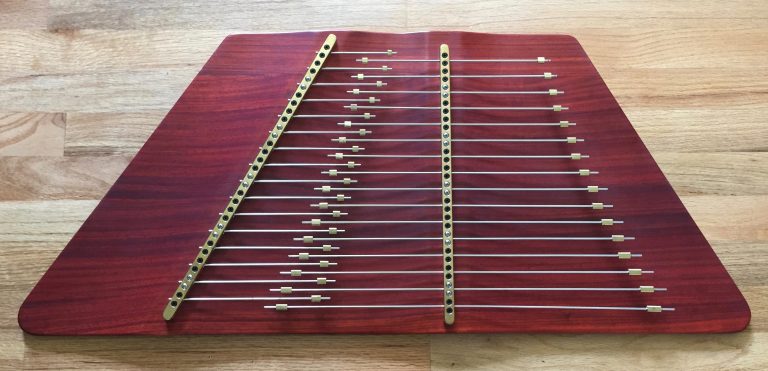
The soundboard has a flat back while the front is carved out to allow for movement of the vibrating rods. The soundboard is about .8” thick under the bridges and its thickness tapers to about .3” at the ends and in between the two bridges. Smaller double bridge models, 13-13,10-10 and 8-8 have the same .8” rod spacing and soundboard form. The numbers refer to their number of rods in each bridge. Their fewer rods just make them smaller and lighter.
Previously I made the bass bridge inclined at the right and a perpendicular treble bridge to the left with notes extending left and right. While that design more closely resembled the traditional bass and treble bridge layout of hammered dulcimers, I believe this new design, with the high treble notes mounted in an inclined bridge at the left and the lower treble notes projecting to the left and bass notes projecting to the right of a more centrally mounted perpendicular bridge gives better acoustic results and still plays with the same hammering patterns that I use on the older hammered Mbiras and dulcimers.
Two Bridge Hammered Mbira with 16-16 tuning layout:
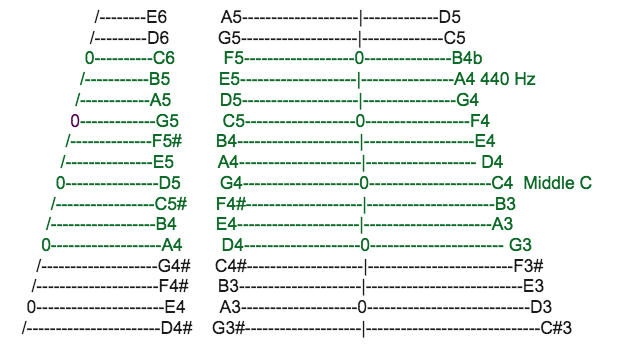
The zeros (0) in the diagram are points that are typically marked with white delrin bridge caps on hammered dulcimers. I use bright stainless screws to clamp those rods and blackened stainless screws to clamp the other rods (|). This helps keep track of where you are when playing.
Two Bridge Hammered Mbira with 13-13 tuning layout:
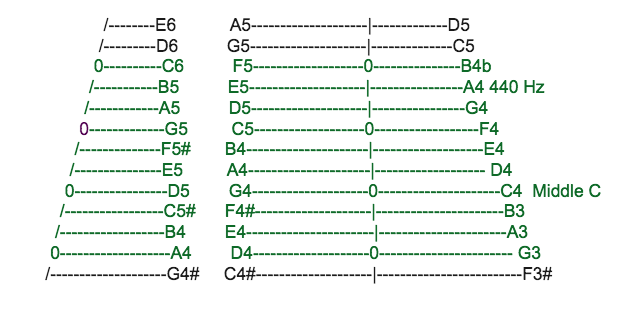
Two Bridge Hammered Mbira with 10-10 tuning layouts:
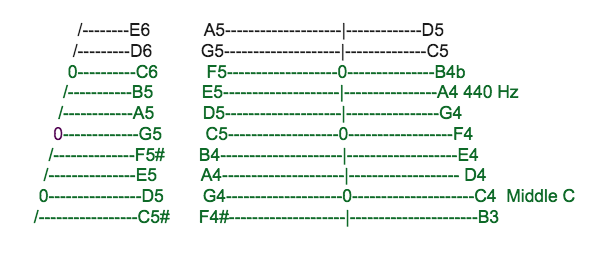
Since each instrument is made to order, I am happy to work with you on a custom configuration.
A comment on size
Most experienced hammered dulcimer players seem to be ordering the 13-13 or may prefer the new 16-16. This is likely because these come closest to the range that they are used to and allows the embellishments and playing in most of the keys that they have on their HD. Personally, I mostly play the melody of Celtic tunes and find that the smaller 10-10 models allow me to play all the tunes that I know. These smaller sizes come close to my original goal of a rugged low maintenance traveling instrument that plays like a hammered dulcimer. To get even closer to that goal, I have started making simple 9 rod single bridge hammered Mbiras.
Single Bridge Hammered Mbiras:.
This instrument is the result of experimentation and a desire for a minimalist traveling instrument. I wanted something that would play Celtic tunes in their common D and E minor keys. I find that the notes available are sufficient to play all the tunes I know. Even though I am not a multi instrumentalist, this single bridge tuning and hammering pattern is close enough to my conventionally tuned two bridge hammered Mbiras and dulcimers that I can easily make the shift to this instrument. These are smaller and lighter than the two bridge instruments and thus are easier to carry when traveling.
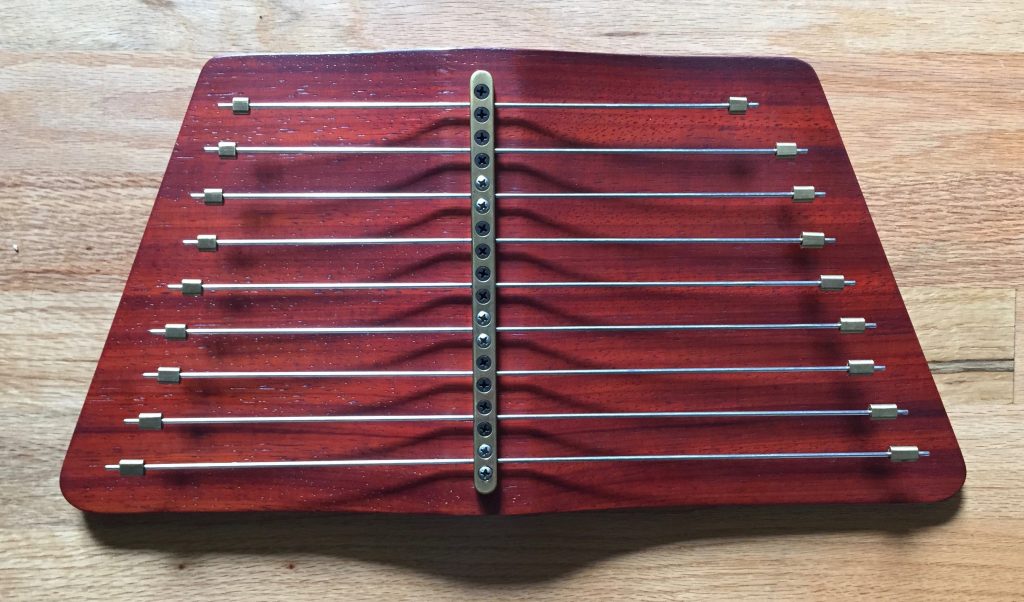
This 9-rod single bridge Mbira with A3 and the lowest note is my current favorite travel instrument. I play it with the soundboard resting in my lap so there is no need for a leg or stand.
Tuning layout for Single Bridge Hammered Mbira with 9 Rods:
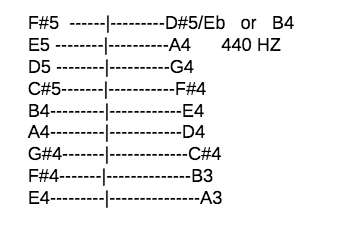
This tuning can also be made an octave lower with D3 as the lowest note or slightly higher with D4 as the lowest note:
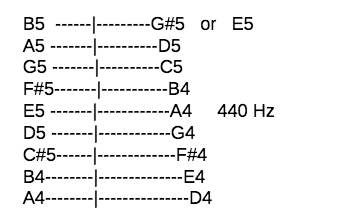
The length of the soundboards will depend on the range chosen with the D4 about 14”, the A3 about 17” and the D3 about 19” long. All three are built with 0.8” rod-to-rod spacing and the soundboards are about 8.5” wide
Small strips of rubber grip applied to the bottom surface of the soundboard allow the instrument to rest securely on your knees for playing while seated. The result is a traveling instrument that fits in my carry on and plays in E minor and D.
16-Rod Single Bridge Hammered Mbira
Here is a larger single bridge instrument that I made based on how much fun I was having playing the large 16-16.
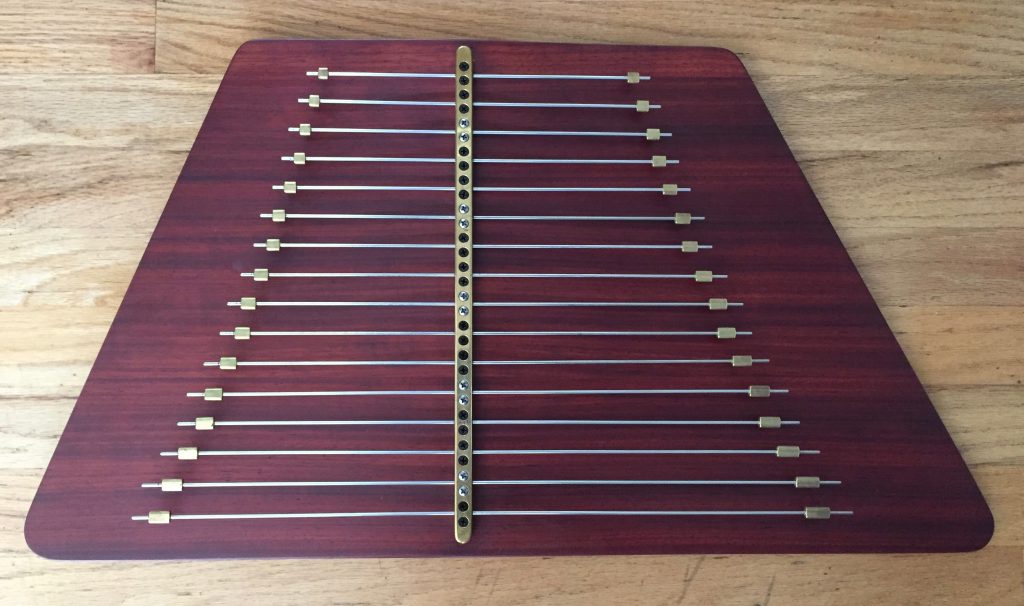
Tuning for Single Bridge Hammered Mbira with 16 Rods:
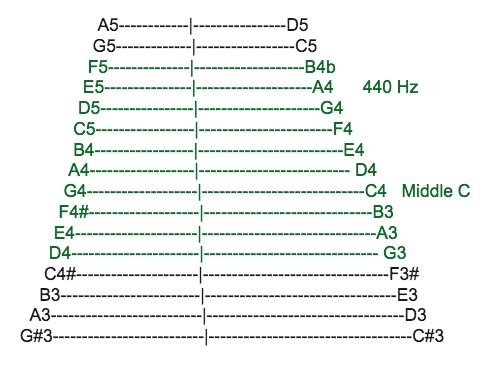
A comment on soundboards:
It turns out that the rods are very high impedance elements thus they work best with a high impedance soundboard. So I have discontinued making instruments with spruce soundboards in favor of stiff heavy soundboards made of Padauk.
Construction:
All instruments are constructed as follows. The bridges are machined out of 360 brass and polished. Each rod has a small brass weight near its end to facilitate tuning and improve tonal color. The rods and screws are stainless steel. Bright stainless screws contrast with black finished screws to mark notes traditionally marked with white and black delrin on hammered dulcimers. The soundboards are carved from solid Padauk and finished with polyurethane. Each instrument comes with two pairs of hammers with head faces chosen to provide different tonal colors. All instruments, except the 9-rod models, come with a playing leg.
Ordering and schedule:
Each instrument is custom built. I communicate with the customer via e-mail to settle on model, tuning layout, any special details and a projected schedule. I require 50% down when I start building and the balance plus shipping, insurance and the package cost when the instrument is received. Start to shipping typically takes 4 weeks.
Hammered Mbira Background:
I got my first hammered dulcimer nearly 35 years ago. I enjoyed learning to play it but found the size and time spent tuning it made it difficult to travel with. I subscribed to a journal on African instruments and to the Journal of Experimental Musical Instruments. I also saw an advertisement for a marimba like dulcimer in Dulcimer Player’s News. I set out to combine a number of ideas and make an instrument that was rugged, small, light, did not require tuning and that played they same as my hammered dulcimer.
The resulting hammered Mbira is a tuned percussion instrument based on a combination of the Mbira, a traditional instrument of the Shona people of Zimbabwe1, with the hammered dulcimer. As in its African forbearer, the sound of the hammered Mbira comes from vibration of metal rods clamped to a soundboard. While the Shona Mbira rods are plucked, the hammered Mbira rods are struck with small hammers with playing technique identical to that used on a hammered dulcimer. The rods are tuned to a western scale and arranged in a note pattern identical to contemporary hammered dulcimers. Thus the hammering patterns of the two instruments are identical. So it is easy to shift between the hammered dulcimer and hammered Mbira.
Hammered Mbiras are typically smaller and more rugged than hammered dulcimers. Since their rods vibrate according to their length rather than tension, the Mbira tuning is less sensitive to changing environments. For those reasons, hammered Mbiras make ideal traveling instruments. They are easy to carry along and you can play them whenever you have a few minutes.
Here is a short recording made on my I-phone of a simple tune played in increasingly higher pitches up the two sides of the right hand bridge then up between the two bridges of a 16-16.
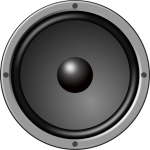
I made a hammered Mbira for Ken Kolodner.
Ken’s instrument is a 13-12. You can see him playing it on several YouTube videos. Just search YouTube for Ken Kolodner Mbira
- Berliner, Paul F., The Soul of the Mbira, Music and Traditions of the Shona People of Zimbabwe, The University of Chicago Press, Chicago and London, 1981